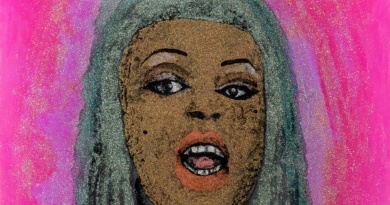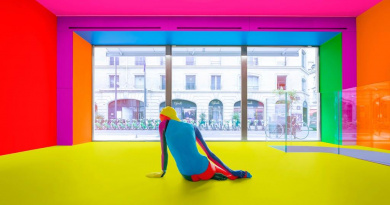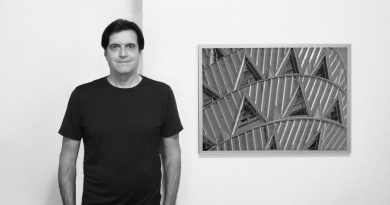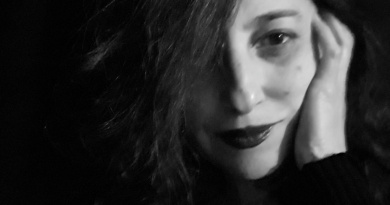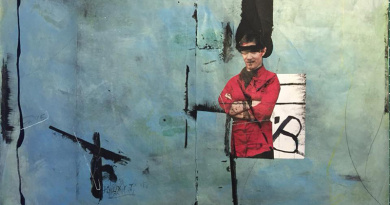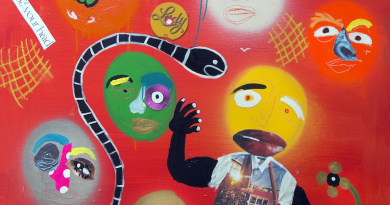Ligia Lewis is a choreographer/director. She’s been making work for 12 years now, having toured extensively over the last 6 years. In her works she researches in a critical way the problems of black history, black feminism and colonialism. She has performed among others at the Ruhr Triennale, HAU Hebel am Ufer Theater in Berlin, numerous theaters in the US and more.
Interview by Dr. phil. Lily Fürstenow-Khositashvili
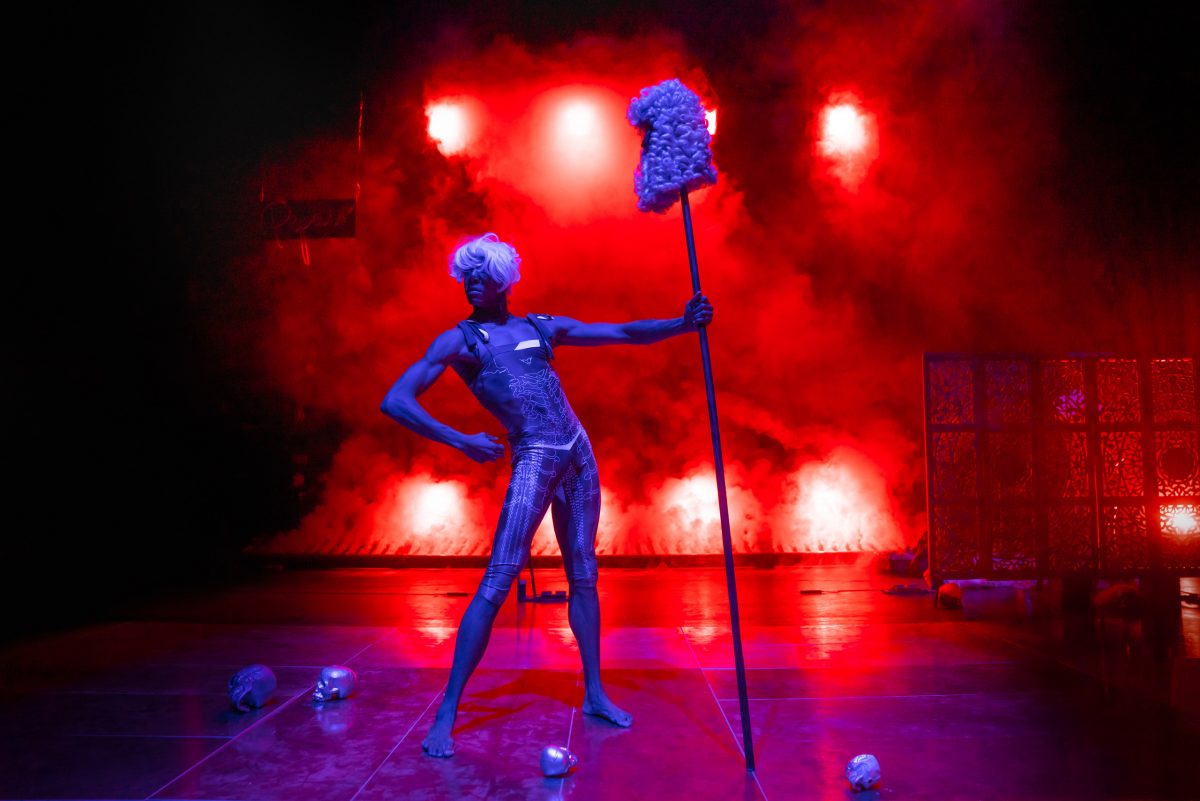
A Plot - A Scandal by Ligia Lewis at HAU Berlin
I've been deeply moved by A Plot / A Scandal that had its premiere at the HAU Berlin recently. My sincere congratulations. What has been the response and the feedback to the piece? I've the impression that not everyone managed to get the core message, judging from one of the reviews in the local newspapers. What would account for that?
As a woman of color presenting work in Europe, I notice a tendency for some to either over- determine what I am doing or to totally miss it. Despite the clarity of expression, concept, or image I’m after in A Plot / A Sandal, there were many oversights made in reviews. For example, I did an interview with a Berlin newspaper reporter to explain the piece and despite this she determined the piece had no clear political message. This of course demonstrates the problem of legibility, especially for black artists working within Europe and journalists who refuse to do the work to come closer to work they don’t understand. And furthermore, the expectation for artists, particularly black artists, to be didactic, reductive, or simplistic in the name of “getting it”. Furthermore, dance journalism is still at the level of spectacle. I develop work from a critical lens which emerges with and through affect. I hope to have the expressive, formal, and conceptual explorations meet while still holding space for the unknown, or that which can not be captured or reduced by language.
What really impressed me, is that you played with gender stereotypes. Why and how did you come up with this fluid gender concept?
Regarding gender more generally, as a black femme I have come to understand how black female embodiment generally queers normative conceptions of gender, making gender at least from a Western perspective if not inoperative, less operative. This has also been an interest of mine inside of my work - to play with this idea of un-gendered flesh. This appears in an early work, “Sensation 1”, and in the piece “minor matter”, a very physical piece where there is wrestling, a strong step choreography, which ends with performers climbing and falling, these sorts of things, and what I really liked about that piece is that no one talked about gender despite the sexual difference of the performers. And that's a very distinct trait, particularly regarding the question of black embodiment. Specifically within "A Plot / A Scandal”, it’s a little different. I was particularly interested in dragging the British figure of John Locke - this enlightenment figure, basically what we would say in the context of the United States - the father of capitalism. He introduces the right to property.This is interesting for me because I tried to put this very question of property in the center of the play in part because by way of the Transatlantic slave trade, black folks and by extension brown and indigenous folk in the Caribbean as well were made property. I’m attempting an overt anticapitalist critique by way of dragging him, the figure of John Locke, and I would like to underline the figure and what that figure represents, a symbol of soul sucking capitalism into a vampire that feeds on flesh, in the performance. This is one of the plots within the three-plot performance. As you can imagine, the right to property in late capitalism does not fare well in the context of Caribbean, particularly in late capitalism.
The whole European project of enlightenment, personified in your piece by John Locke is subverted in your piece, presented as ambivalent and disturbingly deeply violent. Where exactly does capitalism come into play here and how does it aggravate the racial divide?
Humanist ideas of enlightenment seem to have such a huge influence over the globe, yet if you go to a place like Haiti or the Dominican Republic the black people work the land that becomes theirs, but they don't own property, it's not through legal terms that they own it. These are the most precarious people in the context of the Dominican Republic. These are the darker hued folks that also bear the history of marronage. The wonderful scholar, Dixa Ramirez, explores the corners of this island in her research on blackness and indigenous sovereignty.
I had the impression that your female protagonist was overtly sexualised, in the sense of a fallen flesh, is that meant so?
Oh, that's an interesting observation. I wouldn't say that it is purposefully sexualised, but I'm playing with this idea of seduction. In a very playful way I am trying to conjure it inside of the realm of theater and to create this space for imagination: a space where spirit and history exist already. I am very playful in trying to bring the audience into this story. There’s of course the erotics of John Locke, whom I drag in this piece, and with the rest of the piece and the subsequent plots, I’m moving in and out of seduction, repulsion, rage, to arrive at rest.
I was struck by the deepness of the piece and how well-researched it was historically. One really learns more facts from the past. How much of that is personal: is it true that your great grandmother actually practised voodoo?
You are speaking of Lolon, my great grandmother. Yes, she hosted Dominican palo gatherings at night in the village of Dios Dirá. These generally happened at night. It was seen as sinful from a Judeo-Christian perspective to engage in such a ceremony, but despite that she practiced. I share this story in the third plot of the piece because I find her commitment to this ritual and to the (black) community engaged in these rituals at a time of heightened anti- blackness to be radical. I would argue that even today, anti-blackness shapes sensibilities and practices on the island. So any commitment to historically black or africanist traditions are still radical. In terms of the research, I worked with my sister, academic Sarah Lewis-Cappellari, on mapping the different recorded slave revolts that happened in the Caribbean between 1521, up until the Haitian revolution, and there were obviously many, but we name some of the many to grasp the scope of this struggle, this long and seemingly endless struggle, particularly when looking at the present. The revolts don’t stop after what is deemed the first “successful” black revolution, but revolts or rebellions continue and are performed in multifarious ways, including one plot by the black carpenter and artist, Jose Aponte, in early 19th century Cuba. His drawings, depicting black people as kings and queens, are what were used against him in the court of law as an example of his desire to overthrow Europe’s colonial order over the island. Through this piece, I’m weaving different plots together, ones that successfully enter the historical record, but also ones that are considered minor or mundane that otherwise would be overlooked. I’m seeking out different forms of resistance of black and brown folks as we navigate an unjust world.
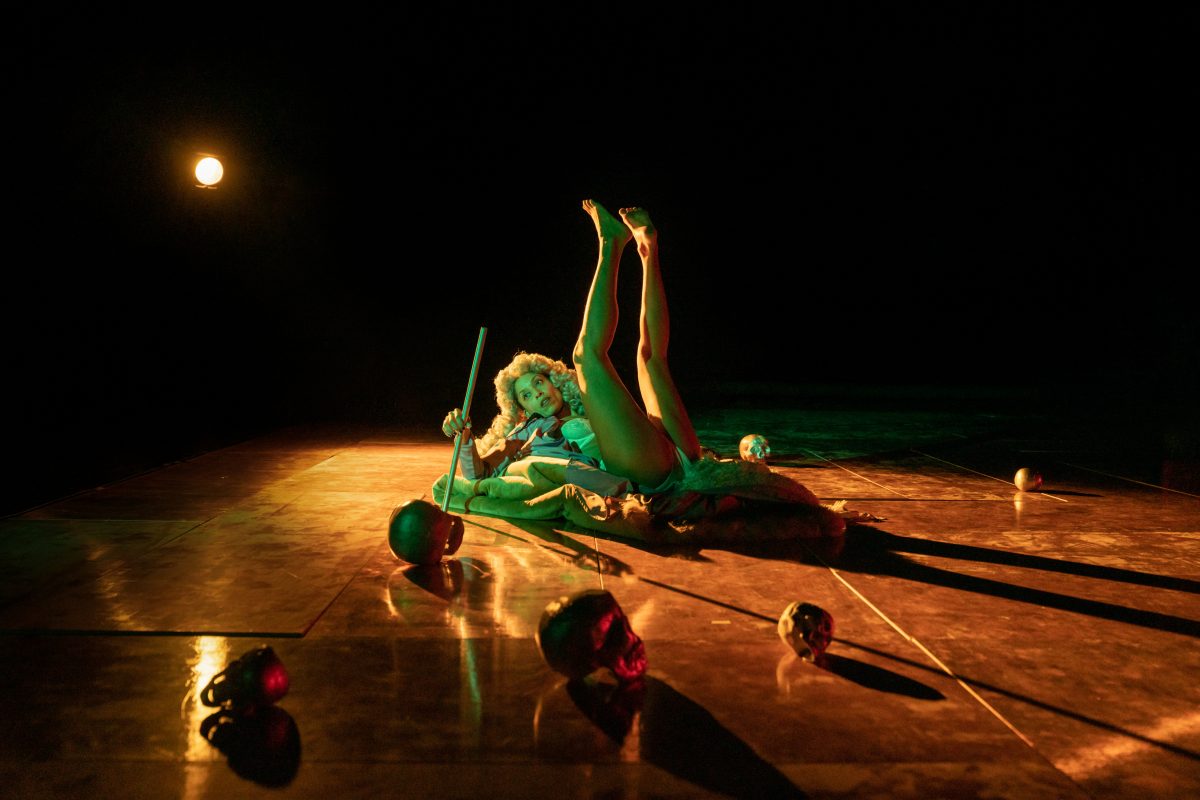
A Plot - A Scandal by Ligia Lewis at HAU Berlin
What is the European colonial involvement into the history of the Carribean?
Because there was an anti-black government at the time, Dominican palo, was practiced at night. Dictatorship had a very long reign over the Haitian Republic accompanied with hostility and what's very sad, this condition is very common in the Dominican Republic. Not so interestingly, Dominicans try to make this distinction between themselves and Haitians, despite the fact that we have a shared history. One of the many tragedies that continue on this shared island is the colonial divide between the Dominican Republic and Haiti, through systemic forms of anti-blackness and colorism. Within this piece, I’m trying to bring the Dominican Republic and Haiti in relation and proximity, out of my own need to plot a deeper connection to those that helped liberate all of us Hispaniola, the Haitian revolutionaries, while also including the greater Caribbean, as our stories are entangled. In (Western) Europe’s attempt at mapping the world in its own image, a global racial-capitalist world ensues. My piece, “A Plot / A Scandal” is the critique of this fact- “a plot, a piece of land, and some property”, as I say it in the prelude of the piece.
How do you deal with the history of violence in your work?
With and through very strong images and with a strong physical presence. Also, my works engage a long process of realization, first through the concept and then the development of the materials of the performance. There is another interesting anecdote related to it. This John Locke who is an enlightenment figure, writing about the natural rights of liberty, is simultaneously writing these laws putting them into place as Europe and the United Kingdom specifically is shifting from monarchy into the republic. He was writing his theories about political law and at the same time about freedom. Yet he is invested monetarily in the slave trade. So he is making money out of it. And once I learnt this I knew that was the starting point of it. This is the cruelty of certain abstractions of thought, that I find Europe is very seduced by. He is making money out of this subjugation.
I've come to the conclusion that a whole lot of things that have been built or came into being in the West, have been done by slave labour. Why is this fact still so ignored in Europe?
Well I’m not sure how to quantify this. I’m more engaged with the psychic space that emerges knowing the (modern) world is made in someone else’s (Europeanised) image. Meanwhile Africa and its peoples dispersed across the globe (also including land, resources, and by extension culture), the black diaspora, have experienced and continue to experience disproportionate forms of exploitation, dispossession and violence. I’m always interrogating this fact. And while the concept of property is central to my piece, so is the continued forms of erasure of Africanist traditions on the eastern part of Hispaniola. Despite that, Dominican Palo continues.
Would this certain degree of spectacularisation of Palo dance (like performing in different contexts other than original ritual related ones) deprive it of its authentic aura?
I wanted to tell the story of my great grandmother, and her commitment to Dominican Palo, also a form of voodoo, not to spectacularize it, but to bring people closer to what I deem as a minor, however incredibly relevant, rebellion. And I align myself with this rebellion and my ancestor’s many rebellions, archived or not. It’s with this spirit that I engage with my work. You see, black and brown (indigenous) folks have endured far too much for far too long. And as the brilliant artist, Nora Chipaumire once stated, “throw salt on your wound and speak!” So comes my piece, with the words : Revenge, Rest, Repair. Repair appearing with a delayed question mark, in neon light.
I think you have a wonderful metaphor for this radical subversion towards the end of the piece - this gesture of uprooting of the stage floor. Because this polished floor surface gets turned up and destroyed revealing the dirt underneath laying it bare and making it evident - a very strong move. You have to tell me more about your movements and gestures because they are very deeply thought through and prepared. Every move in its place with maximum effect on the viewer down to the movements of the eyelids quoting one of your texts.
Speaking of this piece, I knew this very condition of plotting, inspired by a piece of land, a plot, was the starting point. So how am I going to plot throughout this piece? Ok, so I built this floor. Plotting for me in the context of the work was sewing different narratives together, and I developed this through movement and language with a process I call physical narration. All my work is very gestural and theatrical in nature. Formally, I try to find the appropriate language or expression made distinct for each piece. But I often use a recurring modes of physical intensity and humour, where I can, as a way of dealing with the overwhelming burden of history and of representation.
Maybe you could also say a few words about who influenced you as a dancer and choreographer?
About influences, it's such a good question. Conceptually, I would say the Congolese artist, Faustin Linyekula. Our work is totally different, but nevertheless I deeply appreciate his experiments. I mentioned Nora Chipaumire earlier. Ralph Lemon is another choreographer whose research based practice is very inspiring. Film is also inspiring and also more generally being in the world. I’m always trying to tune my intuition by simply trying to participate in the world.
Particularly silent film is a trove of gestures. As for the post-modern dance I agree with you.
Yes, I love silent film. Post modern dance, or at least the canonical form it took, hasn’t inspired me much. Not to mention how that canon is riddled with different forms of erasure, as most canons are. But in general, building a physical language, in a strong visual and auditory landscape, has been something I've been busy with since I started making work.
How do you choose the music scores to your works? They play emotionally a crucial role. For example in that piece Deader than Dead the music score by Guillaume de Machaut from the 14th century adds timeless dimension to human suffering.
The Guillaume Machaut piece was also central to my work, “Still Not Still” as it was the foundation for the stage work as well. I’m an avid music lover. I am trying to discover music and sound all the time. I often use already composed material that I reimagine or put through some sort of altering process to arrive at a new form. For “A Plot / A Scandal”, my twin brother (a.k.a Twin Shadow) composed an original score, with his oft collaborator Wynn Bennett. This was a pleasure project because they are wonderful to work with as was my sister, Sarah, and my light designer, Joseph Wegmann and my alternating performance partners Corey Scott Gilbert and Justin Kennedy.
Regarding sound, I asked my brother to be as illustrative as possible in order to have a painterly feel, particularly in plot 1, with a sonic landscape of a British pastoral. The music then slides to richly textured yet sparse saxophone both for the beginning and then at the end with a kind of cathartic cacophony. There’s a hilarious intermezzo for the short break in the piece, where the figure of John Locke cleans up his mess.
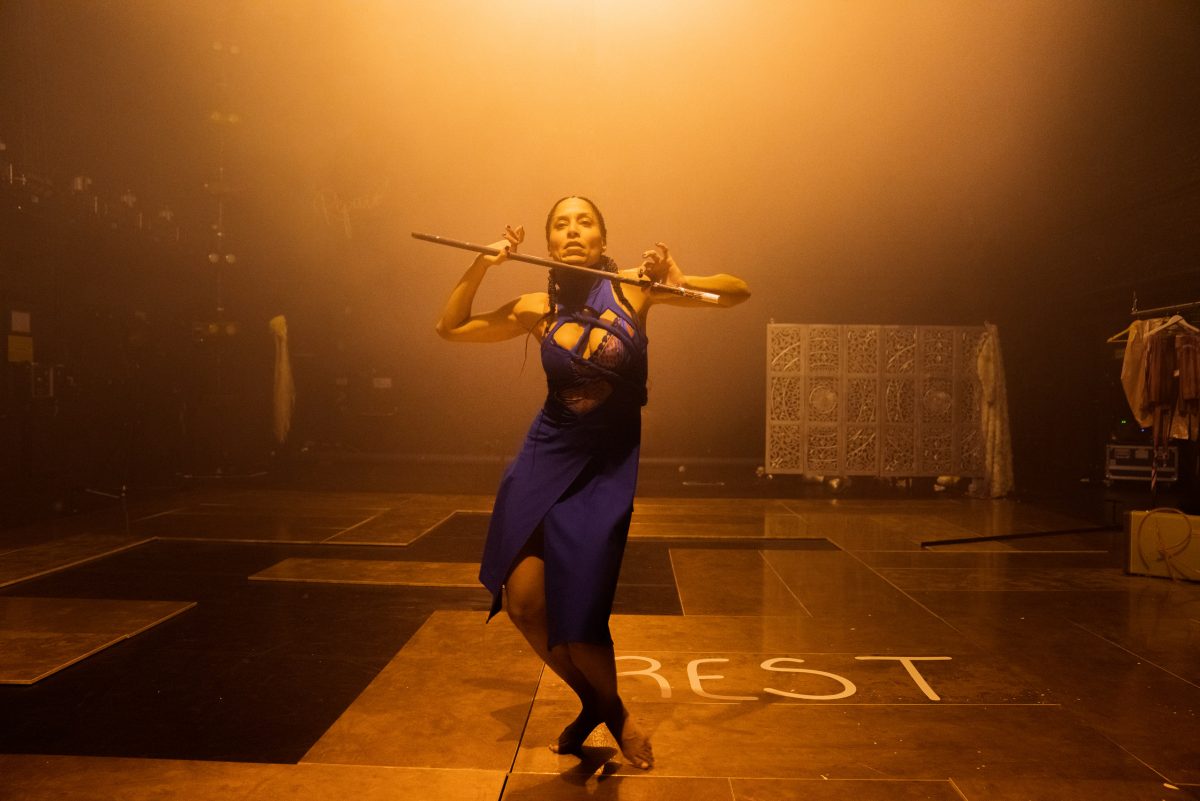
A Plot - A Scandal by Ligia Lewis at HAU Berlin
What role does the public, the audiences play in your work? For example during the piece you stepped out of the stage and addressed the spectators which was a gesture quite playful and ambiguously threatening too. It made enormous sense in this piece although I am myself not always in favour of coming into contact with the public on such an immediate basis.
Yes, I generally don't do participatory work but particularly in this piece to play with these different forms of intimacy and in contrast, distantiation, were super important to me. Being able to state these very harsh facts alongside more comical moments was also important. Through the seduction of image, which includes sound, movement, and light are all very import while also engaging the public through different modes of performativity.
How has your work been perceived in different contexts, among various audiences? Has there been much difference? Because you said that public is very important when you conceive your works, which is for me too a very essential factor.
Creating art without consideration of the public is strange to me. I like to think that my work is a kind of service, one I don’t take for granted. I’m trying to maintain a sense of urgency in what I do and I stay humbled by the various impasses that I’m confronted with in the context of Europe and the U.S. It’s always a pleasure to play outside the US and Europe. I’ve had the fortune of presenting in Tunisia and Brazil among a few other places. But in general, I’m well aware that there’s so much more work to be done.
Exactly. That's what the uprooting is for?
Yes. Precisely this. Fucking up the plot. Creating space for other plots to emerge, one’s that are more radical, irreducible and open up to the ethical demands of a world in ruins.
Presenting difficult work is problematic, isn't it? Especially writing about difficult work is such a challenge, e.g. on German colonialism, this topic is being pretty much avoided here.
Yes, it’s difficult in Germany. And that’s why some of us continue to do our work.
I have problems about the term "indigenous". It's applied in a derogatory sense towards anyone different or from outside of Western Europe, isn't it?
The question of indigeneity is difficult and one I’m hesitant to speak to. It’s a political term now as indigenous people are making ethical demands on land rights and reparations. The question of land is also central to that conversation.
As a great admirer of Edouard Glissant I keep citing him over and over and I can't keep from saying once again that as he put it the whole contemporary civilisation as we know it comes from the plantations, meaning slave labour. With us thinking of ourselves as being so liberal and open-minded. It's quite a shocking revelation, and what can be done about it?
The logics of empire have been so well secured, and for so long, operating in overt and also covert ways. Neoliberalism seems an inescapable horror and the demands for accountability for historical wrongs seems more and more difficult to claim.
So what is the role of art in all of this? How much politics should there be in art?
It's a very good question. Well, I never believed in the autonomy of art, that always felt like an utterance made by and for the privileged and elite. So in consideration of this and for me a deep sense of interdependence, I guess, I wish for more ethical engagements with the things around us, not in a provincial way, but rather from a more global or planetary sensibility. Thinking on this scale, but through minor movements seems to make the most sense to me.
Ligia Lewis, thank you very much for the interview.
works as a choreographer conceiving and directing experimental performances. Lewis’s works, often marked by physical intensity and humor, seek to animate subjects through expressions that disrupt normative conceptions of the body while negotiating the ghostly traces of history, memory, and the unknown. Through her choreographic scores and compositions, she develops expressive concepts that give form to movements, speech, affects, thoughts, relations, utterances, and the bodies that hold them. Thus her work slides between the familiar and the unfamiliar. Held together by the logic of interdependence, disorder, and play, she creates space(s) for the emergent and the indeterminate while tending to the mundane. In her work, sonic and visual metaphors meet the body, materializing the enigmatic, the poetic, and the dissonant. Lewis’s work continues to evoke the nuances of embodiment.
Our online magazine is free of advertisements. We do everything out of love and dedication. We are not profit oriented. Support Tagree that the magazine remains ad-free and the monthly costs can be paid. TAGREE, I love your cultural work, I donate to show you my appreciation, voluntary, one-time or regular monthly or per quarter:




